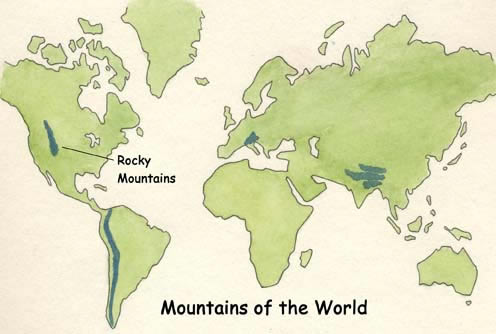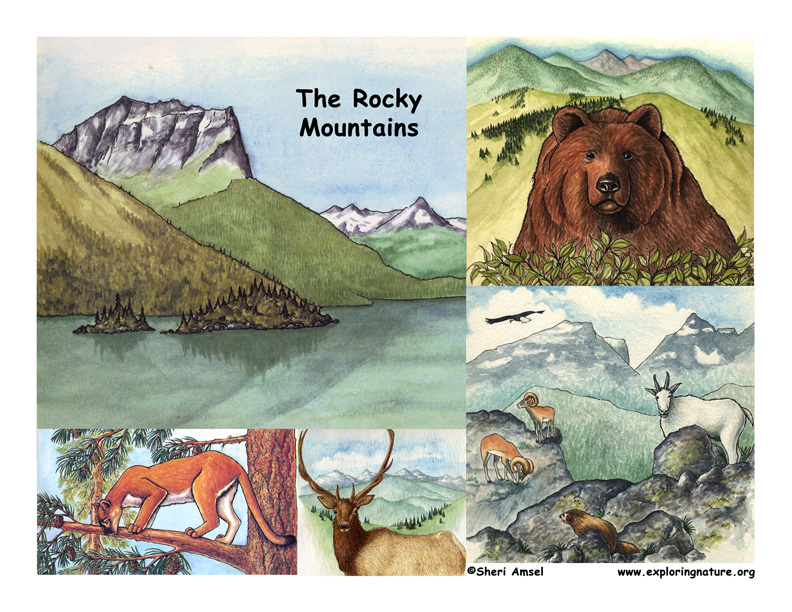

The Rocky Mountains stretch 3,000 miles like a jagged backbone down the western United States and Canada.
The Rockies form the continental divide. This term means that the river systems on one side of the continent flow toward the east and on the other side they flow toward the west. Forested slopes lead up to sparse rocky summits. People come to the Rockies to see all the different wildlife and experience the wilderness. As a way to save these areas for everyone to enjoy, the national parks were formed. There is so much wildlife and so many great views that too many people come to visit these parks. Now, to keep a habitat natural, human traffic has to be limited.
They are home to a lot of wildlife; like lynx, bobcat, and cougar (also called a mountain lion or puma). The big cats hunt deer, snowshoe hare, mice and grouse. Seeing a cougar in the wild was, for many years, a rare and amazing sigh, but this was because of over hunting and the lion's shy nature. But in the beginning of the 1990s whitetail deer numbers were very high, and with all this food, the cougar numbers rose. Grizzly bears still roam in the Montana and Canadian Rockies, but like the cougar, they need large tracts of wilderness on which to hunt and breed. The numbers of grizzlies decline as roads and development push through the northern Rockies. Herd of bison and elk are a familiar site in Yellowstone National Park. Unlike the great herds of bison that made the ground shake when they pass, Yellowstone bison herds are kept down to a number that will not overgraze the park's grasslands and foothills. On the lower slopes, ruffed grouse blend into the underbrush. Weasel, mink, and pine marten are among the smaller predators. Hunting for birds, mice, eggs, or insects, they move quickly through the rocks and trees. Coyotes travel in pairs, families, or alone looking for winter-killed animals or leftovers from a cougar or grizzly kill. Up higher among the rocks, marmots forage for short alpine grasses. Mountain goats and herds of bighorn sheep defy steep cliffs as they leap from rock to rock. Bald eagles keep a watchful eye for small or dead animals to bring back to their nesting young.
On the lower slopes, maple, chokecherry, alder, and water birch provide forage for groups of mule deer. Higher up on the mountains, Englemann spruce, western larch, and ponderosa pine take over. The eastern slopes of the Rockies are arid, with fewer trees and a sandy grassland feeling. Here and on the high alpine meadows, wildflowers bring brilliant color to the warmer seasons of the Rockies. Indian paintbrushes, bitterroot, lupine, and balsamroot cover the hills. Wild geranium lure elk, deer, and even bears out of the forest to graze. Bear grass sends its tall white shoots in the air.
When you research information you must cite the reference. Citing for websites is different from citing from books, magazines and periodicals. The style of citing shown here is from the MLA Style Citations (Modern Language Association).
When citing a WEBSITE the general format is as follows.
Author Last Name, First Name(s). "Title: Subtitle of Part of Web Page, if appropriate." Title: Subtitle: Section of Page if appropriate. Sponsoring/Publishing Agency, If Given. Additional significant descriptive information. Date of Electronic Publication or other Date, such as Last Updated. Day Month Year of access < URL >.
Amsel, Sheri. "Rocky Mountains" Exploring Nature Educational Resource ©2005-2024. December 13, 2024
< http://www.exploringnature.org/db/view/1721 >

